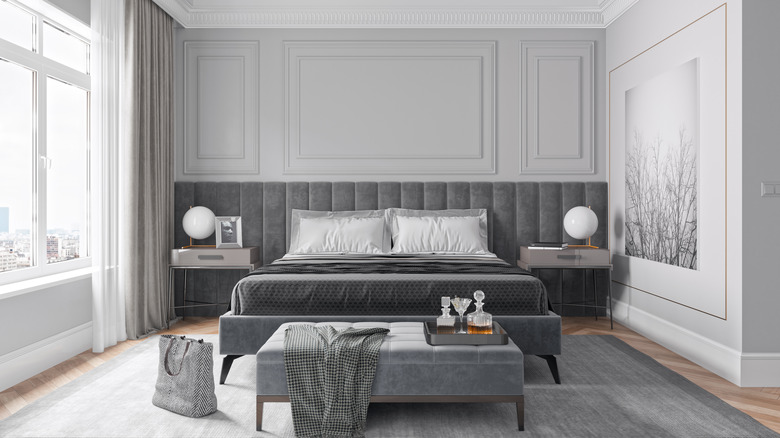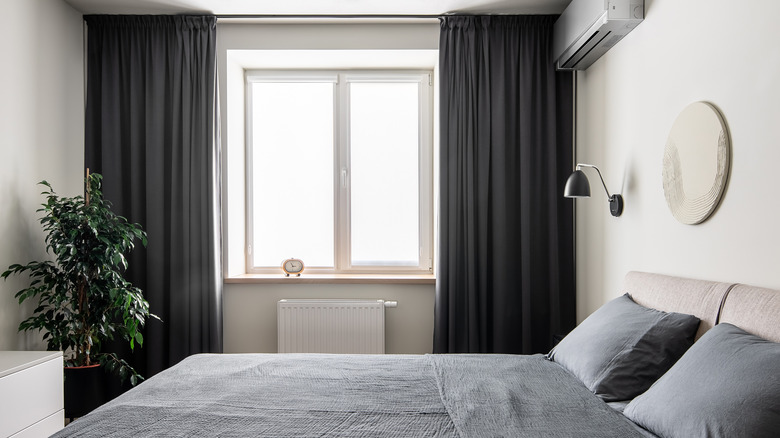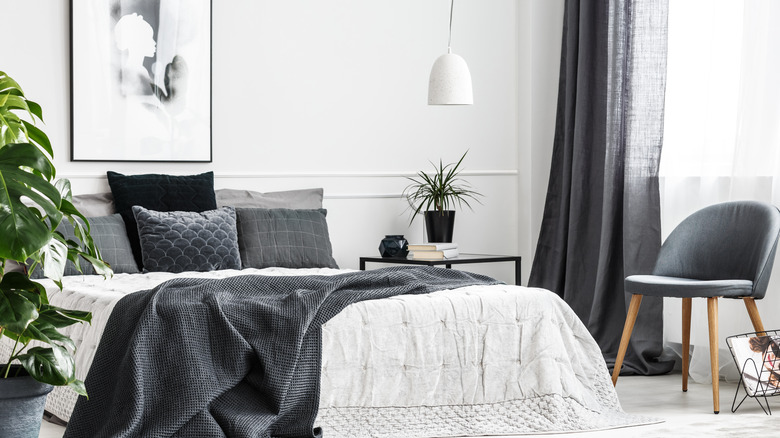Why A Gray Bedroom Is Actually A Good Idea
Gray has evolved to become one of the most popular colors in interior design, trailing only white as the highest-selling paint color. Neutrals are all the rage nowadays, as they are aesthetically pleasing, easy to style up or down, and capable of complementing just about any other hue located on the color wheel. Aside from their visual appeal, neutral colors also offer therapeutic benefits that can provide a nice balance to the hectic and reckless energy surrounding everyday life. It can be smart to use the color gray when decorating a bedroom, as it gives a functional place to start when designing while evoking a calming energy that can help slow your mind before bedtime.
Gray comes with its fair share of negative connotations, as well. Some view the color as too depressing to feature inside a bedroom or feel the hue conjures feelings and thoughts of isolation, doubt, or monotony. Though, two people can view the same shade from entirely different perspectives. When implemented correctly, gray, along with other neutral colors on the spectrum, can bring maturity, stability, and even an air of sophistication into a space. And even if you see the color as boring, combining it with the right hues could transform your bedroom into a well-balanced space that integrates elegant and contemporary styles.
The perks of using gray inside the bedroom
When selecting appropriate color schemes for each room, it's important to consider each room's function. A bedroom, unlike other areas of the home designed for high-functioning activities, is reserved for calming pursuits that ultimately prepare the mind for a good night's rest. Gray is a soothing color that promotes feelings of tranquility and is perfectly suited for winding down after a mentally draining day of work, school, or running errands. Save the reds, oranges, yellows, and other vibrant colors for the more stimulating rooms in your home.
Color has the power to influence more than just mental and emotional well-being. Different hues can also affect your physical state, impacting your heart rate, nervous system, breathing, and serotonin levels. Even if you associate the color gray with dullness or monotony, such feelings aren't necessarily inappropriate for a place of solitude, where a reduced heart rate and relaxed breathing are essential to obtaining adequate sleep. Gray and other neutral colors are capable of adding a warm and natural feel to a bedroom, which could provide a refreshing juxtaposition to more bright and lively spaces around your house.
Offers an aesthetic appeal
From a design perspective, gray, like other neutrals, provides a simple yet effective backdrop for homeowners to begin their bedroom decor journey. When brainstorming ideas for the room's overall aesthetic, start with the color as a base on your walls, bed, or other large surfaces. From there, experiment with other hues that would complement your shade of choice — incorporating small pops of color around the room to offer an appealing contrast. Similar to black, white, and shades of cream, gray is so versatile that it can be matched with virtually any color to generate a color scheme that is uniquely your own.
Although, the color itself is also exceptionally charming, and can easily be used as the focal point of a space. No two shades of gray are exactly the same, and each of these shades could be paired with others like it to create a monochromatic color scheme. Lighter shades of gray tend to emit a relaxing vibe, while darker shades express a more dramatic flair. Mixing the two can generate an aesthetic that combines both of these elements. Play around with different textures, as well, to keep the room from becoming one-dimensional. Designers commonly use throw pillows, carpets and rugs, furniture, and other decorative elements to diversify and add texture to a space.


